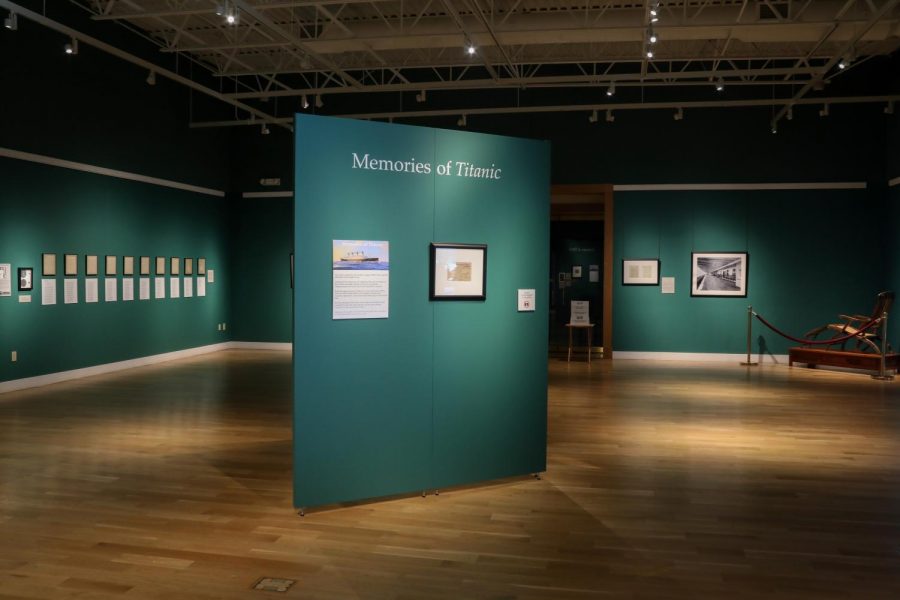Art museum commemorates Titanic disaster
Contributed by the Minnesota Marine Art Museum
The exhibit, “Memories of the Titanic”, is a curated collection that explores the human cost of the disaster on Apr. 15, 1912. The exhibit also includes the hourly breakdown of the event, as the ship sank less than three hours after colliding with the iceberg.
September 30, 2020
Winona’s Minnesota Marine Art Museum is exhibiting art and artifacts from the Titanic disaster.
The exhibit, “Memories of Titanic,” is a curated collection that explores the human cost of the disaster on Apr. 15, 1912. First-hand accounts, postcards, letters and diaries from survivors, paintings of the tragedy and even an original deck chair offer chilling primary perspectives of the event. Telegraphs of the news reports, newspaper articles and an ornate 8-foot model of the ship lend a secondary recollection of the “unsinkable” Royal Mail Ship (R.M.S.) Titanic.
The exhibit also features commissioned works and paintings about the famous ship exhibited only once previously. Journals and letters by survivor Laura Cribb account the disaster and harrowing emotional toll due to the loss of her father in the Atlantic Ocean. Included along with Cribb’s artifacts is a uniform button of a steward from the rescue ship, Carpathia.
Two paintings displayed are by American Impressionist painter Colin Campbell Cooper. He reportedly painted them on the deck of the rescue ship, depicting the morning after the tragedy. Cooper also reportedly gave up his cabin on the Carpathia in order to house survivors of the Titanic.
The exhibit also includes the hourly breakdown of the event, as the ship sank less than three hours after colliding with the iceberg
Among the exhibit is an excerpt about two of the passengers on the Titanic: Isidor and Ida Straus, who were also shown in James Cameron’s “Titanic” film. Straus, a co-owner of Macy’s Department Stores, and his wife reportedly refused to be separated and said they would rather die together on the Titanic. Before the sinking of the ship, Ida is purported to have said “I will not be separated from my husband. As we have lived, so will we die, together.”
For many, the appeal of the Titanic echibit is about the tragedy itself. Jon Swanson is the curator of exhibitions and collections for the Minnesota Marine Art Museum. He says that while the tragedy affected many people, his interest in the exhibit leans more towards the ship itself.
“I appreciate the stories, survivors‘ accounts, and all the struggles and drama surrounding the tragic loss, but for me personally my interest as a nautical archaeologist is the design of the ship, and the story behind the search and discovery of the wreck as well as protecting the site from looters and treasure hunters,“ Swanson said.
The ship was one of the largest of its time, at 882 feet long, roughly the length of three football fields, and weighing 104.6 million pounds, which equaled the weight of nearly 17,300 cars. At its tallest smokestack, the ship was 175 feet tall, larger than the tallest building in Winona, the Watkins Warehouse and Manufacturing Building, which is 160 feet tall.
The tragedy and its subsequent exploration
have long been a subject of media fascination, inspiring eighteen movies in various languages, and fifteen documentaries. Despite the dramatization of the wreck, the human cost remains harrowing; 1,500 of 2,224 passengers died in the North Atlantic due to drowning and exposure. While many depictions are often deeply romantic, the tone of the exhibit is poignant and powerful, and the human cost of the tragedy is made that much more real by the human artifacts.
The opinions expressed in this paper are not necessarily those of Winona State University, the Minnesota State Colleges and University system, or the Winona State University student body.







































































